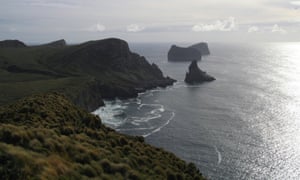 |
| Rodents escaping ship, artist Ron Druett |
The million dollar mouse and the New Zealand Navy
Ten rangers, three sniffer dogs, a government minister and members of the New Zealand defence force have been dispatched on a special mission to hunt for a rodent – known as the million-dollar mouse – living on remote islands in the sub-Antarctic.
The inhospitable Antipodes Islands are located 470 miles (760km) south-east of New Zealand and were until recently home to a 200,000-strong mouse population, thought to have been introduced by sealers or a shipwreck more than a century ago.
The mice – the only introduced mammalian pest on the island – ate albatross chicks alive, devastated vegetation and threatened rare insect life.
In an attempt to eradicate them two years ago, New Zealand raised NZ$1m (£526,000) and embarked on one of the largest and most ambitious extermination programmes undertaken anywhere in the world.
In June 2016, 65 tonnes of cereal-based rodent bait was dropped by two helicopters over a total area of 2,045 hectares (5,051 acres) of the islands. The airdrop was supported by a 13-strong crew on the ground, who spent 75 days exterminating an estimated 200,000 mice.
Now, the first monitoring team from New Zealand has departed on the HMNZS Wellington to spend three weeks hunting for mice in the world heritage site, to see if the project was a success.
New Zealand conservation minister Eugenie Sage, who was onboard the ship steaming south, said the expedition was exciting but nerve-wracking.
“As with any island eradication, success is never guaranteed. The Antipodes operation was delivered to international best practice – however, the sheer challenge of eradicating 200,000 mice from such a remote and wild part of New Zealand should never be underestimated,” Sage said.
“If any mice had survived the operation, the population would have rebounded by now to a level where they should be detectable … the international community will be watching closely.”
Stephen Horn, the project manager for the department of conservation, said getting on to the islands was the team’s first challenge, with the crew having to scale 18-metre (59 feet) cliffs to access their accommodation.
“The mice are having a massive impact on a whole range of species,” he said. “The beauty about the sub-Antarctic Island that is so far away from New Zealand is that over time it has developed its own unique range of species. There is rare, threatened, endemic species out there that we’re looking to protect.”

No comments:
Post a Comment